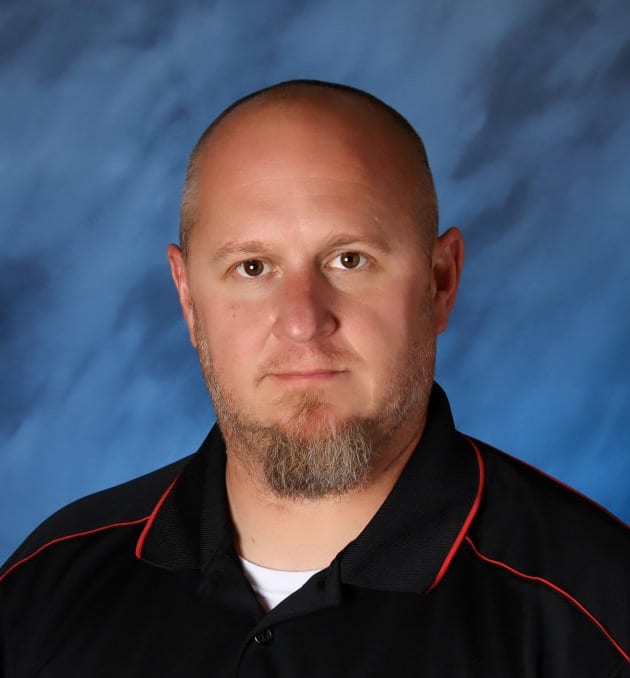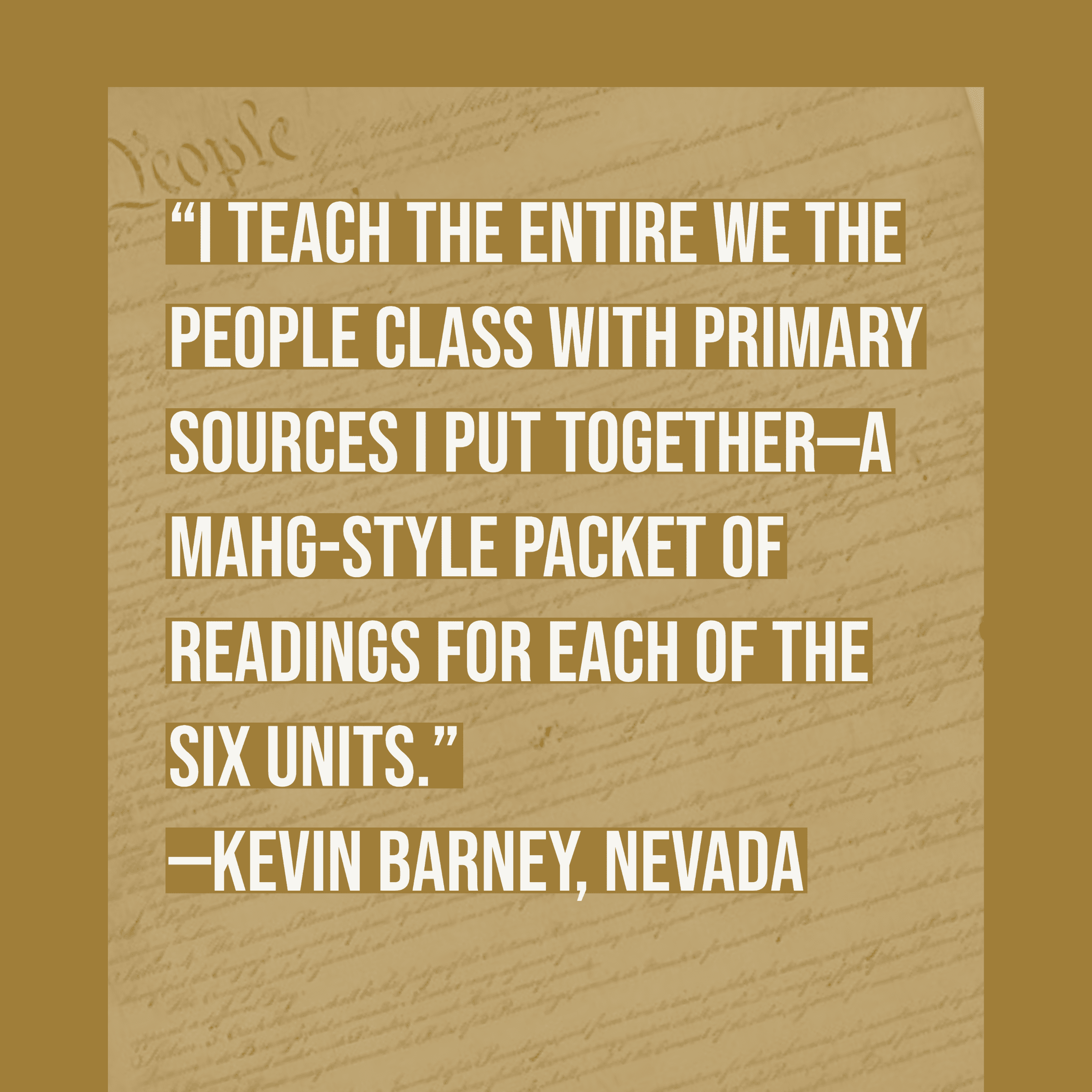Meet Our Teachers
Kevin Barney

What does America most need now? “People who remain committed to their core principles,” answers Kevin Barney, who teaches history and government at Veterans Tribute Career and Technical Academy in Las Vegas, Nevada. “Citizens’ principles should be stronger than the passions of the day.”
Most of Barney’s students are second-generation Latino immigrants. Many applied to the small public magnet school (with a student body of 800) because they are interested in public service jobs in law enforcement and emergency response, the focus of the elective classes at VCTCA. They also come to the school to get a high-quality education. Some leave high school and are immediately hired as 911 dispatchers; others enter police academies or complete their certification as Emergency Medical Technicians so as to join fire departments. Many go on to college and careers in other fields. They carry with them skills they learn in Barney’s classroom.
Primary Documents Help Students Understand the Principles of Democracy
Few students begin Barney’s Advanced Placement United States History (APUSH) course with a mental outline of American history already in place. Their immigrant parents could not pass along to them a history they did not know. Yet Barney does not set out to fill students’ minds with historical facts. “They have a phone on them”—they can look the facts up, Barney says. He frames his lessons “on what they’re going to do with the facts. How can they turn the facts into an argument?”
The core document volumes published by Teaching American History provide Barney with the resources he needs to teach in this way. A graduate of the Master of Arts in American Government and History program (MAHG), Barney studied the documents in seminars with other teachers, honing his ability to analyze the arguments and perspectives they contain.
Before Barney (who is the 2016 James Madison Fellow for Nevada) enrolled in MAHG, “I used primary documents more as a supplement to the textbook. Now I use them as the base of what we do.” He guides students as they analyze the documents, helping them develop critical reading skills they will need in college, careers, and throughout their lives as citizens. In the meantime, students discover which points of view they agree with and which they do not. They begin to shape their own understanding of democracy and the principles that should guide it.
MAHG Supports Inquiry-Based Learning
In addition to APUSH, Barney teaches Advanced Placement US Government and dual enrollment courses on American history and culture through a local community college. All of his lessons are “inquiry-based,” as the National Council for the Social Studies recommends. Questions about history and government also drive MAHG study. Barney offers examples: “‘How revolutionary was the Revolutionary War?’ and ‘Does the Bill of Rights still adequately protect citizens from the government?’—scholars still debate these questions; there are no necessarily right or wrong answers. This way of teaching is very MAHG style: you have a compelling question, supporting questions, and a whole bunch of historical sources students work through to answer those questions.”
Barney laughs, “In MAHG, the professors never answered the questions. It was always: ‘What do you guys think?’ The professors were really good at leading discussions—even at leading online discussions, which is not easy!”
Students Read TAH Core Documents to Prepare for the We The People Competition
During the first half of his AP Government course, Barney covers the themes of the annual We the People competition, a national program of The Center for Civics Education. His AP Government students compete in the program, beginning with a district-level contest in early January. Much of what students need to prepare for the competition also prepares them for the AP exam they take in May. Barney considers this time of preparation the best part of his teaching work. “It’s the perfect mix of everything we learned in the MAHG program—American history and government.”
 The We the People curriculum is organized thematically into six units, each analyzing the American Constitutional system from the perspective of its historical development or social impact. But instead of relying simply on the textbook designed for the competition, “I teach the entire We the People class with primary sources I put together—a MAHG-style packet of readings for each of the six units,” Barney says, adding that almost all the readings are documents he studied in MAHG.
The We the People curriculum is organized thematically into six units, each analyzing the American Constitutional system from the perspective of its historical development or social impact. But instead of relying simply on the textbook designed for the competition, “I teach the entire We the People class with primary sources I put together—a MAHG-style packet of readings for each of the six units,” Barney says, adding that almost all the readings are documents he studied in MAHG.
Design Lessons So Students Must Speak—But Without Embarrassment
Sometimes his students work through the documents “MAHG style—we put our desks in a circle and discuss questions I’ve given them in advance.” But to build students’ skills, he uses a variety of other exercises. For example, for a lesson on “how judicial review has changed the Constitution, we do a pro se court.” Like defendants who represent themselves in court, all of Barney’s students develop and defend a stance on a Supreme Court opinion they’ve read. First, Barney divides the class into thirds. One third develops arguments that the court opinion affirms the original understanding of a section of the Constitution. Another third will argue that the opinion reinterprets the passage in a way that effectively changes its meaning. A final third will judge which argument is more persuasive. After each group prepares, he redivides the class into groups of three. In each group, one member argues that no Constitutional alteration occurred, another argues that it did, and the third judges who is right.
Such small group exercises help reluctant speakers develop debating skills. Barney finds his students often “don’t want to be wrong in front of their peers. If they can sit quiet, they sit quiet.” He designs lessons so that “it’s not possible to be silent. If you’re the only one on your team with a certain role, you have to speak.”
Another lesson helps students discover their core political beliefs. Unit Two of We the People covers the Federalist/Anti-federalist debate during the ratification of the Constitution. The first course Barney took in the MAHG program focused on this debate. Despite the lengthy required reading, Barney loved the class (taught by Professor Christopher Burkett). Although “it’s easy to dismiss the so-called losers in history,” Barney concluded that the Anti-Federalists foresaw many of our current problems. Since then, Barney has asked his students to consider the Anti-Federalists’ case. He asks them to read Brutus I and summarize the author’s warnings that the new federal government will grow too powerful, losing touch with the will of the people. “Then I make them come up with modern examples of that happening.” Barney presented his lesson plan on the Anti-Federalists at the National Council for the Social Studies Annual Convention in 2017.
“You Need Some Evidence?”
Unit 3 of We the People focuses on “how Constitutional change has furthered the ideals in the Declaration of Independence.” It covers the 13th, 14th and 15th amendments, passed during and shortly after the Civil War. Barney assigns his students two documents that he read more than once during his MAHG work: an excerpt of Lincoln’s long Peoria speech (1856) along with Confederate Vice President Alexander Stephens’ “Cornerstone” speech (1861). The latter proclaims that the Confederate government’s “cornerstone rests, upon the great truth that the negro is not equal to the white man; that slavery subordination to the superior race is his natural and normal condition.” Lincoln asserts the contrary understanding of democracy: “No man is good enough to govern another man, without that other’s consent. I say this is the leading principle—the sheet anchor of American republicanism.”
Barney asks students, “You need some evidence of what the Civil War was about? Well, what did they say it was about?” Students quickly realize that Americans knew “they were fighting over what the Declaration actually means—who democratic government is actually for.”
Barney’s students excel in We the People. “For three out of the past four years, we’ve done well enough to go on to the state competition.” This year, although students competed online due to the pandemic, “for the first time ever, we came in first in the district.” Barney’s district is the fifth largest in the nation, encompassing about fifty high schools, many with student bodies four times the size of VTCTA’s.
As Students Discover Their Own Convictions, They Find Common Ground
Yet Barney wants more for his students than this victory. “I want them to discover a core ideology that’s more important to them than any partisanship” preoccupying the current news or social media stream. “I often tell my students, ‘I don’t care what you believe politically. I care why you believe it. I want to hear your evidence—why you think this is right.’ Students respond to that,” Barney says.
In the end, most students “discover that there is something at the core of America that holds us together. When first presented with the claim that all men are created equal, many of them think, ‘That’s just for white men.’ It takes a while, and maybe not everyone is convinced, but most realize that this is a universal declaration. It doesn’t mean we’ve always lived up to it.” Still, “whatever you may think about protests like the Black Lives Matter movement, those protesting want to be treated equally—that’s all it’s generally about. We all want the ideals in the Declaration to be totally true.”
